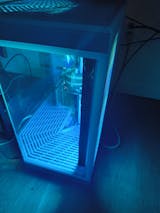If you've noticed that your PC is running hotter than normal or that it has trouble running games or heavy workloads, thermal paste could be the cause. People don't always pay enough attention to this important part of your computer's cooling system. This is why it's important and how to deal with it.
What Is Thermal Paste and Why Does It Matter?
Thermal paste is a substance that conducts heat between your CPU and its cooler. Its role is to fix minute defects on both components' surfaces, allowing for effective heat transfer from the CPU to the cooler.
Thermal paste has the potential to deteriorate, dry out, or lose effectiveness over time. This leads to poor heat conduction, leading your CPU to overheat. High temperatures can cause thermal throttling, poor performance, and even long-term damage to your system.
When Should You Check or Replace Thermal Paste?
- Age of the Build: Thermal paste can last anywhere from 2-5 years, depending on the quality of the paste and usage conditions. If your PC is older and hasn’t been serviced, it’s time to check.
- Unusual Temps: Use software like HWMonitor or Core Temp to check CPU temperatures. If idle temps are over 40°C or load temps exceed 80°C, you might need a reapplication.
- Upgrades or Cooler Replacements: Any time you remove the CPU cooler, you should reapply fresh thermal paste.
How to Reapply Thermal Paste: A Step-by-Step Guide
Tools You’ll Need:
- Isopropyl alcohol (90% or higher)
- Microfiber cloth or coffee filters
- Thermal paste (popular brands include Arctic MX-4, Noctua NT-H1, or Thermal Grizzly Kryonaut)
- A plastic spreader or a pea-sized patience (you’ll see why!)
Step 1: Power Down and Prep
- Turn off your PC and unplug it from the wall.
- Discharge any static electricity by touching a grounded metal object.
- Remove the side panel of your case to access the CPU cooler.
Step 2: Remove the Cooler
- Carefully detach the CPU cooler according to the manufacturer’s instructions.
- Be gentle to avoid bending the CPU pins (if using an AMD processor) or damaging the cooler mount.
Step 3: Clean the Surface
- Use a microfiber cloth or coffee filter dipped in isopropyl alcohol to clean off the old thermal paste from both the CPU and the cooler.
- Be thorough but gentle—residue can interfere with the new application.
Step 4: Apply Fresh Thermal Paste
- Apply a pea-sized dot of thermal paste in the center of the CPU.
- For larger CPUs, you can use a small X pattern or a thin line. Avoid using too much paste—it can spill over and cause issues.
- No need to spread it yourself; the pressure from the cooler will do that evenly.
Step 5: Reattach the Cooler
- Carefully reattach the CPU cooler, ensuring even pressure to avoid bubbles in the thermal paste.
- Tighten screws in a crisscross pattern to maintain balance.
Step 6: Test Your Temps
- Power up your PC and monitor CPU temps using your preferred software.
- Check for a noticeable drop in idle and load temperatures.
Pro Tips for Success
- Don’t Skimp on Quality: Budget thermal pastes may save money, but they frequently underperform. A high-quality paste will last longer and withstand higher thermal demands.
- Avoid Conductive Pastes for Beginners: Some high-performance pastes, such as liquid metal, are electrically conductive and require special handling to avoid short circuits.
- Stay Cool Under Pressure: If you're apprehensive about the procedure, practice on a spare component or view a lesson video for visual assistance.
Maintaining the thermal paste on a regular basis is a simple but effective way to keep your PC running at its best and temperatures under control. Get extra care for your CPU. It will thank you whether you're gaming, editing, or just reading.
Keep cool and play games! 🎮















